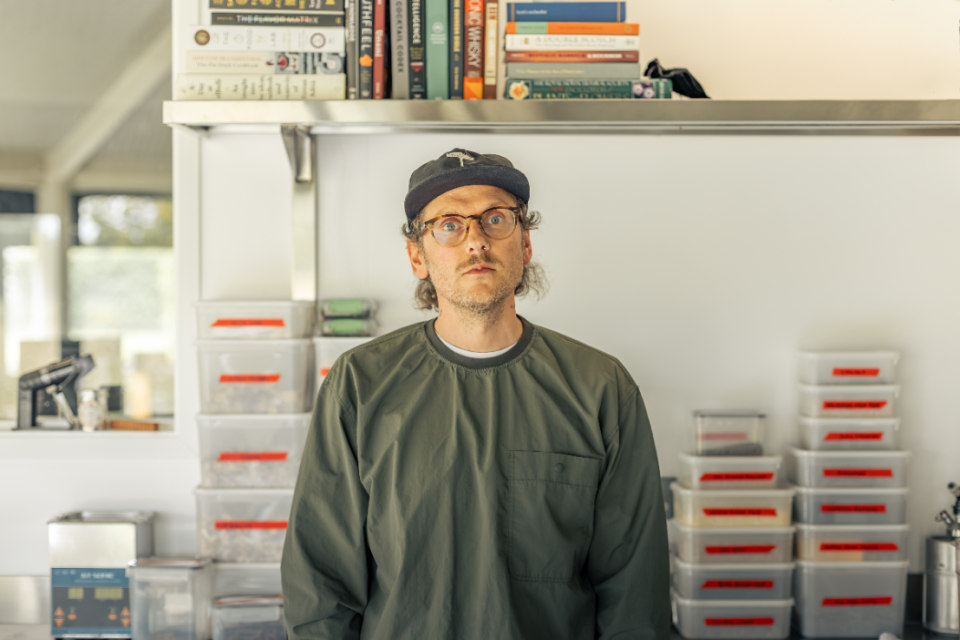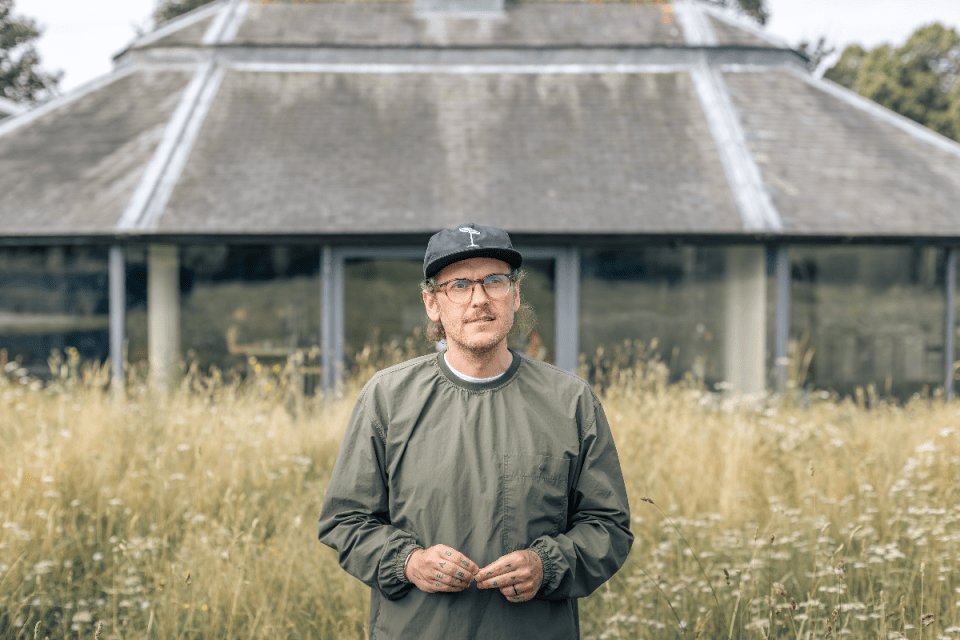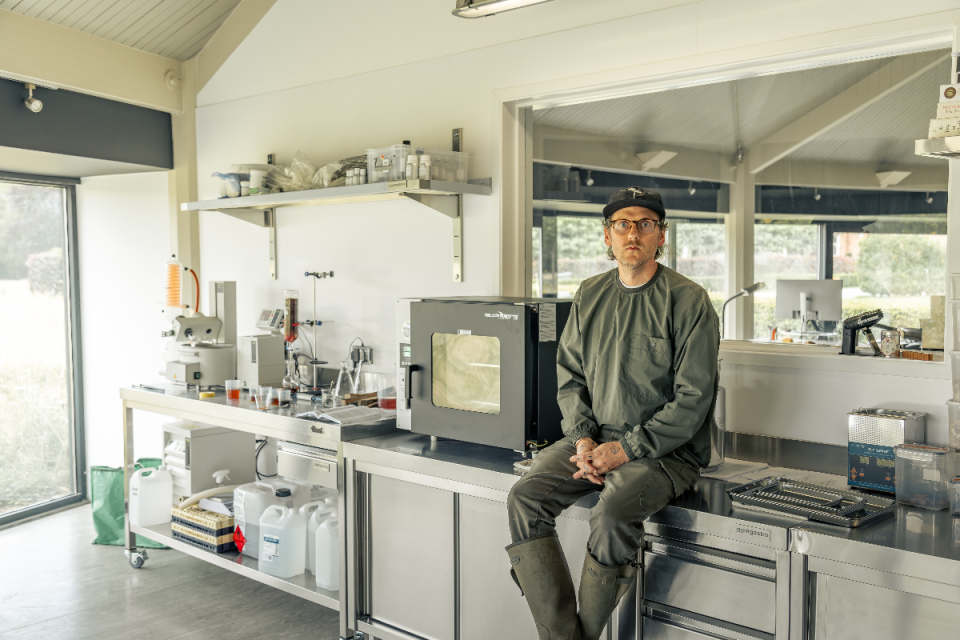Seedlip is worth billions, but its founder has a new alcohol free drink on his mind. We tried it first.

Ben Branson birthed the alcohol free spirits scene when he launched Seedlip nearly ten years ago. Five years after selling his majority share, he’s ready to change the face of drinking. Again. He talks to Adam Bloodworth
Through the launch of Seedlip, Ben Branson established a reputation as the founding father of the alcohol free scene. With the range of botanical spirits, he showed how grown-up drinks needn’t be inextricably linked to poison. But in 2019, the farming boy from North Lincolnshire sold his majority stake to Diageo for an undisclosed, but certainly huge, amount (the brand is now worth billions globally.) It bought Branson time to dream up Pollen Projects, the company he believes can reimagine the alcohol-free scene afresh. Again.
It’s the type of oven-hot day where just getting the train out of London induces clothes-to-skin sweat, but the wildflower meadows wrapped around Branson’s futuristic glass-walled testing centre remind me that heat in the countryside is different to heat in the city. No wonder he finds this an easier place to think. Here, the high-tech laboratory is purposefully in the middle of a field replete with colourful little flowers that shake in the wind, so Branson can walk outdoors to blow off steam, or find inspiration. “I recently discovered we have this incredible black walnut tree in the forest,” he says, gesturing to a far corner of the 25 acres of wildland we’re standing in the middle of. When he talks about trees Branson’s eyes bulge wide like a Disney prince.
After five years of ruminative thinking, Branson is having his second go at scene-leading innovation, this time by extracting flavour from thousands of types of wood to create a new range of dark spirits. “We’ve explored them medicinally, but we’ve not explored trees for taste and flavour, and that becomes incredibly exciting,” says the 41-year-old, dressed in an expensive-looking forest green tee that blends into the landscape.

After a decade as the posterboy for the alcohol free scene you might imagine Branson to be jaded. “Seedlip led the way but things have moved on a lot since then,” Laura Willoughby, the founder of London’s only booze-free bar, told City A.M. And some experts say there is “no evidence” alcohol free reduces drinking. But Branson says that he’s just getting started.
He passes me a dram of the liquid he calls Sylva. I’m the first journalist to try the product, and that feels like a privilege, but also a bit like Christmas morning when you unwrap presents and say they’re great whether you like them or not. My first thought was that Sylva has brilliant strength, the North African padauk tree wood offering a fresh flavour profile I haven’t tasted before. It’s light, bright and sweet, though the mouthfeel needed some work (I hadn’t tried the final retail version which was still being worked on weeks before launch). Is this the next frontier in alcohol free drinking?
Read more: London alcohol free bar criticises major drinks brands as ‘ignorant’
We walk by water, through a forest and past pigs that’ll soon provide “500 sausages for Christmas.” We stop to check for sounds on his bird watching app. He clutches that black walnut tree, rips a clutch of leaves, and presents them to me like Rafiki holding up Simba. I take a sniff, and the collection of spindly branches does smell great. A tent under one tree is where he and his daughter go camping when the clutches of his country pile feel boringly grown up.
There are over 73,000 types of trees Branson could test for flavour, but the focus will be on British varieties. “Knowing that 9,000 trees aren’t discovered yet, and celebrating the magic of that kind of brilliant diversity of provenance and flavour is fascinating to me,” he says. “We’re trying to find the most efficient and effective way to make the best dark non-alcoholic experience possible.”

Seedlip launched in 2015 as the world’s first distilled non-alcoholic spirit, and there are now hundreds of competitors, particularly in white spirits. The rise of brands has led to an inevitable quality issue, believes Branson, given the industry is unregulated. It is a poisoned chalice: experimentation is rife because of the lack of rules, so we’re living through non-alc’s Prohibition, but then again, cowboys are trying to make a quick buck with bad products. “I’m not seeing in dark, non alcoholic liquids the same level of craft, attention, provenance, process as we see in fantastic dark alcohol,” he sums up.
How on earth do they choose which to test from 73,000 trees? “That’s a really good question,” admits Branson. Local trees, exotic wood suppliers to the musical instrument world, and samples sent by industry colleagues are in the queue, including a recent piece of thermo-treated, toasted Ash that smells like coffee and Christmas pudding. “That’s something we want to explore.” Next year Pollen Projects hopes to launch laboratories in New York and Kyoto, focusing on local wood. The timber isn’t always terribly interesting. Describing a recent trail with mulberry, Branson slows his speech. “It was amazing from a flavour perspective, but it didn’t work. The liquid became really cloudy and wouldn’t clarify so we had to park that.”
I haven’t got any Oompa Loompas, but I love the imagination of Roald Dahl. I love that world. We’re trying to do things that people haven’t done before. Maybe not to the same Everlasting Gobstopper extreme, but we are saying ‘what if?’
Bottles of booze are lined up on shelves around the laboratory like trophies, but Branson hasn’t touched a drop in over ten years (he works with one full-time colleague, researcher Jack Wareing, who isn’t sober.) “What we are trying to achieve is a liquid you can sip that’s grown up, a liquid that has complexity and character and body and depth and a really amazing finish.” The industry talks about a ‘burn’. “I don’t think anybody loves the burn of alcohol, but if it’s not there, you miss it.”
How does the actual science bit work? It’s complicated, but distilled to GCSE level: wood is cut into chips, then baked in an oven. It then goes through a process called sonic maturation, which uses oxygen, pressure, heat and ultrasound to extract flavour and colour. Oxygenated, pressured stainless steel kegs (their version of a barrel) is filled with grain distillate and wood and aged in an ultrasonic maturation chamber. Ultrasound waves crash into each other to produce high energy and small bursts of force, happening in liquid tens of thousands of times per second, and these waves extract the flavour and colour. “This effectively means that we can do what a traditional barrel does, but rather than waiting for years to achieve the required flavour we can get there in a matter of days.”
I admit to both men that their explanation completely went over my head and both laugh big laughs, like they knew I was about to say that. Doing tours of this very much workspace (it is not open to the public) is millionth on their to-do list. Put simply, the complex procedure isn’t meant to be understood by plebs like me. So I choose a metaphor of my own. “You’re a bit like Willy Wonka,” I say to Branson, hoping he’ll play along. Steel kegs, pipettes and glass filtration devices remind me of Mike TeeVee’s ‘I’m going too high!’ scene in the 1971 Gene Wilder film. “I haven’t got any Oompa Loompas,” he says, buying into the joke. “But I love that story. The imagination of Roald Dahl. I love that world. We’re trying to do things that people haven’t done before. Maybe not to the same Everlasting Gobstopper extreme, but we are saying what if?”
Read more: Like a virgin? The expanding world of alcohol-free cocktails
What does all this blue sky thinking mean for Seedlip, given Branson still has a minority stake? The week I visit he has been filming promotional videos for them, days before the crucial launch of Pollen Projects’ first product (the one I tried.) It must be “challenging” being the face of both, I ask diplomatically. Branson laughs, then pauses. “Yeah. I’m @seedlipben on Instagram,” he says, before going into rehearsed PR speak. “Seedlip is still not even nine years old yet, the category is just getting going and I still feel like we’re literally only just scratching the surface on what’s possible with Seedlip as a brand and a business. So no, there’s still loads. We’ve still got a really big job to do.” I said that Seedlip feels like yesterday’s news and Branson laughs: “It’s amazing that nine years is yesterday’s news.”
It’s not all wildflower meadows on the alcohol free scene: some dissenting voices dislike how conglomerate-backed drinks like Seedlip are becoming ubiquitous behind bars and supermarket shelves. They say the power of backers like Diageo makes it hard for independent brands to find space. Rob Fink, founder of the Big Drop Brew Company, believes the challenge for independent drinks brands is how to convince supermarkets, bars and restaurants that consumers want a choice between brands owned by global mega-companies and independent brands. “Sometimes the only way to prove that is to be on the shelves, or in the taps and demonstrate a good rate of sale. But more often than not, it is too expensive to get there in the first place.”
Ellie Webb, founder of Caleno Drinks believes large spirits corporations “always” hold more competitive power because they are “able to leverage the might and scale of their large brands, to secure opportunities for their non-alcoholic variations,” but she sees a silver lining. “Bigger corporations can help grow visibility of the no and low category through big budget advertising campaigns and sponsorships, whilst independents can drive innovation, new thinking and ways of doing things.”
A week later in London, Branson and I are drinking coffee near King’s Cross. He’s just finished his podcast recording where he talks about working and living with ADHD when I bring up the topic of accessibility for new makers. He answers by calling out another problem. Has it got harder for new producers? Does Seedlip have too much power? “Yes, and no,” he says. “I mean, it might interest you that there’s independent non-alcoholic spirits buying their way into bars, which is actually really unhelpful. Independents have launched with deep pockets that are just spending their way in.”
He doesn’t immediately appear to have much sympathy for the argument about Diageo dominance. “I would just say that if people have got great liquids and people have got great brands,” he begins, “there is enough opportunity and diversity and variety within non alcoholic that bars should take it seriously.” He says that there is now a market for low-and-no, compared to when he started, and that he helps independent makers when they approach him. Surprisingly, Branson also argues creatives may be being too experimental. “Maybe what they’re doing might be too dissimilar to Seedlip. Bartenders want to have products that people know.”
“We are saturated in our choices of what we can eat and drink. We have more options than we know what to do with and our repertoire of what we drink has never been more fragmented, we are more promiscuous than ever in our drinking so it’s more competitive than ever.”
And there it was: a glimpse at the steely determination Branson utilised to kick-start a new global market nearly ten years ago. Can he do it again?
Sylva costs £40 from sylvalabs.com